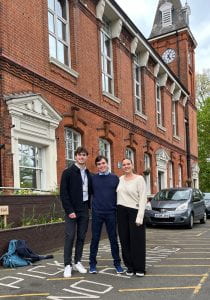Promoting Employee Volunteering Schemes in Merton
Executive Summary
Background
Merton Connected is a charitable organization commissioned by the London Borough of Merton that has been supporting and driving the Voluntary, Community, and Social Enterprise (VCSE) sector in Merton since 1984. They collaborate with and assist organizations across this sector to develop volunteering, deliver social prescribing, and provide home visit services. They also develop community-benefiting partnership activities, such as fundraising, training, and financial management for both well-established and new organizations with social objectives.
Located in the heart of the socioeconomically disadvantaged east side of Merton in Mitcham, Merton Connected is not solely an observer but an active participant in the daily lives of people struggling with social and financial hardships.
Methodology
The goal of this project was to evaluate the existing employee volunteering schemes in the London Borough of Merton and recommend ways for Merton Connected to enhance and encourage more participation in these programs among employees and employers. We achieved this goal through three main objectives:
● Objective 1: Assess the impact of employee volunteering schemes in Merton.
● Objective 2: Evaluate current and best practices in employee volunteering schemes.
● Objective 3: Recommend how Merton Connected can help foster and improve employee
volunteering schemes in Merton.
These objectives involved interviewing individuals from VCSE organizations, companies, and third-party organizations who were directly involved in employee volunteering and providing recommendations based on the commonality of those responses. We accomplished our project goal and objectives during our time in London in March and April of 2024.
Findings
There were several common themes discussed across all stakeholder groups, including motivations for participating in employee volunteering, barriers to participation, incentives for companies to offer such programs, promotion of volunteering opportunities, patterns in employees likely to volunteer, feedback from employees, and types of volunteering schemes.
One of the major barriers to employees engaging in employee volunteering was not having enough time to participate. Almost every representative we spoke to pointed out that limited time was a major reason why employees were unable to participate in volunteering. Most stakeholders said that employees feel like they do not have the availability to take a full day off to volunteer considering the pressure they are under from tasks in their daily jobs. Another major barrier was the lack of awareness, promotion, and information on all sides (employers, host VCSEs, and third-party organizations). In some stakeholder interviews, the interviewees said that there are even senior-level employees who do not know about employee volunteering opportunities or paid time off available to engage in them. Our survey data also reinforces this idea with 40% of respondents saying the lack of information is a barrier to volunteering.
Despite these barriers, we found that employee volunteering is very well-received and enjoyed. Virtually all of the VCSEs that we spoke with had no negative feedback to report about the experience with employee volunteers. Likewise, most VCSEs said that employees had little to no negative feedback to give. From our survey, 72% of participants of employee volunteering said they were motivated to volunteer for training and skill development. Another common motivation was that employees were motivated to participate in their employee volunteering scheme because they liked the idea of being able to do something good or make a positive impact.
Conclusions and Recommendations
Based on our findings, we compiled a list of recommendations to help Merton Connected improve the current employee volunteering schemes in Merton. Overall, we found that employee volunteering schemes mutually benefit both the employees and employers, as well as the organizations hosting the volunteering activities. These schemes emphasize corporate social responsibility, career and personal development, and feelings of fulfillment. Below are some of our main conclusions and recommendations.
Time, Workload, and Flexibility
Conclusion: Major factors for employee participation in employee volunteering schemes are time, workload, and flexibility of the employee.
Recommendations: Encourage employers to add more flexibility when developing their employee volunteering schemes. Encourage VCSEs and Merton Connected to have more standardized training in the borough.
Promotion and Awareness
Conclusion: A successful employee volunteering scheme requires adequate advertisement to the employees.
Recommendations: Employers should use as many ways as possible to promote the mission and volunteering opportunities to employees, such as workplace advertisements, newsletters, and personally addressed messages. Merton Connected and host VCSEs in Merton should utilize promotional strategies to connect with companies, such as LinkedIn advertisements.
Matching Technology
Conclusion: There is limited technology in use that allows for seamless matching from employees to host VCSEs in Merton.
Recommendations: We recommend that Merton Connected generates a user feedback form focused on matching employees to volunteer opportunities for current technology and record how long it takes for feedback to be implemented. Contact representatives from the system currently in place who are involved in implementing user feedback changes and describe concerns about unheard feedback and the length of time that it takes to make changes to the system.



